|

Live, From GW, It’s CNN’s “Crossfire”! | Technology Campus Marks 10 Years | On the Front Lines of Disasters | Darr Joins Democracy Online Project | Faculty Focus: Artful Actor | Two Million and Counting | Petrie to Lead Emergency Management Effort | Feldman Named D.C. Professor of the Year | Something Old, Something New, Something Buff and Gold and Blue | Dean Receives “Extraordinary Contributions” Award | GW Launches Summer Tour for Curious Minds | At a Glance | GW in History

Live, From GW, It’s CNN’s “Crossfire”!
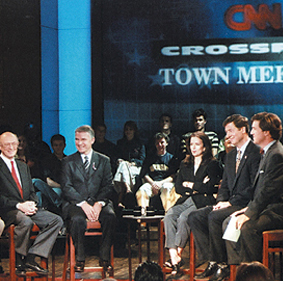 In a groundbreaking partnership, The George Washington University and the Cable News Network announced Feb. 27 that they will combine forces to bring CNN’s longest running political debate program to the GW campus on a permanent basis. “Crossfire” at GW is set to begin April 1. In a groundbreaking partnership, The George Washington University and the Cable News Network announced Feb. 27 that they will combine forces to bring CNN’s longest running political debate program to the GW campus on a permanent basis. “Crossfire” at GW is set to begin April 1.
The newly restructured, one-hour show will air live from the 250-seat Jack Morton Auditorium in GW’s new Media and Public Affairs Building five nights a week at 7 p.m. It will feature new hosts James Carville and Paul Begala, “on the left,” along with Robert Novak and Tucker Carlson, “on the right,” taking on a wide spectrum of powerhouse politicos in the expanded, live-format environment.
“This partnership provides a unique educational and enrichment opportunity for our students in the School of Media and Public Affairs and across the University to witness and participate in national public policy dialogues,” said GW’s President Trachtenberg. Indeed, the partnership includes exclusive internships and priority audience participation for GW students. In addition, CNN and GW will seek to make the program a premium destination for conference attendees and tourists—particularly secondary and college students—visiting Washington, D.C., from around the world. The University is now establishing a unique “e-ticketing” process for “Crossfire”and will work with the Washington, D.C., Convention and Tourism Corporation, the Chamber of Commerce, the Board of Trade, Congressional offices, and other groups as part of its outreach program.
While the permanent move to GW is new, this is far from the first time CNN producers have loaded up their trucks and shipped the show across town to our campus. They did so several times in the past decade, including the two weeks following the Sept. 11 tragedies. At that time, the show drew packed houses as it aired in a special town hall format, with such featured guests as U.S. House Minority Leader Dick Gephardt (D-Mo.) and Sen. John McCain (R-Ariz.).
GW students expressed enthusiasm for the expanded CNN role on campus. Said Roger Kapoor, president of the Student Association, “GW has always been a place of spirited political debate. . . . Students are excited to bring television’s greatest political debate show to campus.”
The students share their excitement with the two new hosts of “Crossfire,” Carville and Begala. According to CNN, the hosts are already dueling. The network reports that Carville says, “I’ve fought the Bushes. I’ve fought the Starrs. I’ve fought the Thornburghs. Now I am ready to take on the Novaks and the Carlsons. ‘Corporal Cue Ball’ is ready to go after the ‘Prince of Darkness’ and ‘Bow Tie Boy.’” Tucker Carlson had a well-placed rejoinder: “How do you whimper in Cajun? We’ll find out,” he predicted.
GW Vice President Michael Freedman’s Communications Division will oversee the University’s roles and responsibilities in the partnership. The veteran broadcast executive and former general manager of CBS Radio Network News led the negotiations and said he and his staff will work closely with CNN and SMPA faculty to ensure a positive experience for GW students.
For those readers who don’t always follow the business intricacies of broadcasting hierarchies, CNN is a division of Turner Broadcasting System, Inc., which is an AOL Time Warner Company. Among others, it encompasses 16 cable and satellite television networks; three private place-based networks; two radio networks; 12 Web sites; and CNN Newsource, the world’s most extensively syndicated news service.
The cover of this magazine features Virginia’s new governor, GW alumnus Mark Warner. In the article he’s quoted as saying that, when he was a student here, he “majored in Washington, D.C.” This new partnership should enhance that “major” for any student who is similarly inclined.
Note: GW alumni planning a visit to Washington, D.C., may contact the University via phone for “Crossfire” tickets, available at no charge. The number is (202) 994-8-CNN.
—Sandy Holland
Back to top | Spring 2002 Table of Contents

Technology Campus Marks 10 Years
Like a parent with a growing child, many at GW find it hard to believe that 10 years have passed since the University opened its technology campus in Ashburn, Va. Now, with the purchase of a new building (the former PSINet headquarters located next door), and a new dean with a new vision, the campus is heading into its next decade of growth.
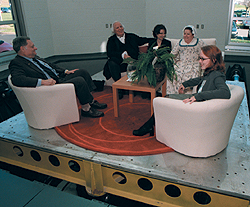 |
|
The east coast’s largest earthquake simulator at GW’s Earthquake Safety lab, shown here with President Trachtenberg, campus staff members, and GW’s George and Martha Washington. |
An idea conceived 15 years ago during the infancy of the Virginia technology boom, the Ashburn campus has grown up nicely into its state-of-the-art campus facilities near the Potomac River in Loudoun County. From an initial student base of 200 and $50,000 in funded research, the campus now has more than 3,000 enrolled students and a funded research list that tops $28 million.
Many of GW’s high-tech initiatives are located in Asbhurn, where classes in subjects such as information technology, advanced engineering, and management are geared toward the area’s working professionals.
Three new research labs opened their doors during the campus’ 10th-anniversary celebration in December. The America Online Home of the 21st Century Laboratory is a research partnership in which GW and AOL will develop and test new technological innovations for the home. The Driving Simulator Laboratory, a partnership with the Federal Highway Administration and General Motors Corp., conducts research on how to develop warning systems to prevent accidents caused by such situations as road distractions or driver drowsiness. The third lab is the Earthquake Safety Laboratory, a partnership with the National Science Foundation in which GW houses the East Coast’s largest earthquake simulator.
 |
|
Executive Dean
John S. Wilson |
John S. Wilson, Ashburn’s new executive dean, will guide the campus into its next decade. Having served as a development director and as assistant provost of the Massachusetts Institute of Technology, he knows what it takes to run a top-tier research university.
“I can imagine us being for Northern Virginia what Stanford has been to Silicon Valley and what MIT has been to Boston’s Route 128,” he says.
Wilson outlines a three-part core plan for the campus to focus on its strengths in information technology and telecommunications, transportation, and biotechnology.
The opening of a major training center for the National Transportation Safety Board serves as an anchor transportation project. The facility, being built on adjacent land owned by GW, will be used to train specialists on how to investigate transportation accidents. The facility will attract students from many government agencies worldwide. In addition to the NTSB project, the Federal Aviation Administration has granted $3 million to GW to develop aninternational aviation safety and security program.
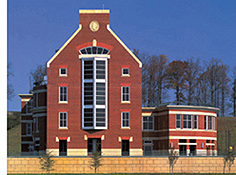 The AOL lab will serve as the cornerstone information technology activity. And when GW takes over the PSINet building, it will be the home of GW’s new initiative in biotechnology research. The AOL lab will serve as the cornerstone information technology activity. And when GW takes over the PSINet building, it will be the home of GW’s new initiative in biotechnology research.
The objective of excelling in the three core areas can now be met with the new building, Wilson says. “This acquisition will put us in a much better position to be the kind of resource we imagine being for this region and beyond.”
—Heather O. Milke
Back to top | Spring 2002 Table of Contents

On the Front Lines of Disasters
Coast Guard Capt. Mike Egan fought off the feelings of shock and denial and sounded the alarm for a terrorist strike when American Airlines Flight 11 crashed into the North Tower of the World Trade Center. As chief of the National Response Center, Egan, a PhD candidate in the School of Engineering and Applied Science, operates the weapons of mass destruction hotline for the United States and provides first alert to senior federal and state officials.
 On watch Sept. 11, he and his staff convened the National Response Team, dispatched emergency portable satellite communications to “Ground Zero” at the World Trade Center, coordinated service support for the Coast Guard’s strike teams, and dispatched liaisons to the Federal Emergency Management Agency, Environmental Protection Agency, Department of Transportation, National Military Command Center, and the Joint Forces Command. On watch Sept. 11, he and his staff convened the National Response Team, dispatched emergency portable satellite communications to “Ground Zero” at the World Trade Center, coordinated service support for the Coast Guard’s strike teams, and dispatched liaisons to the Federal Emergency Management Agency, Environmental Protection Agency, Department of Transportation, National Military Command Center, and the Joint Forces Command.
Developing the ability to put aside the emotion, make decisions and assessments, and prescribe solutions in crises are some of the goals of the Institute for Crisis, Disaster, and Risk Management program at GW, where Egan and 79 other students are pursuing degrees and certificates.
“I spent the first 12 days at the Pentagon involved with decontamination of responders,” says Lisa Westerman, who is pursuing a GW graduate certificate in crisis, emergency, and risk management at GW. “Upon completion of that response, I was deployed to New York City to the Emergency Operations Center of the Office of Emergency Preparedness, where I spent two weeks involved with the management of healthcare assets.” She says involvement at two levels, as a responder and manager, provided unique opportunities to build on her academic work.
Jack Harrald and Joseph Barbera are the directors of the Institute for Crisis, Disaster, and Risk Management, which was chartered in 1994. “The thrust of our program is that we see emergency management emerging as a profession that has a theory as well as a practice,” Harrald says. “We’re somewhat unique as one of two doctoral programs in the country.”
One element inherent in most of the course and institute work is communication. Interagency and interpersonal communication are critical in crisis and disaster situations such as Sept. 11, particularly at Egan’s level. “We rapidly established communications with FEMA and the National Military Command Center in the Pentagon prior to the aircraft striking that facility,” Egan recalls. “We initiated a massive sealift of survivors off of the southern tip of Manhattan and within 90 minutes, we established a system of port control where we screened all passengers and crews of ships arriving and departing U.S. ports in a coordinated effort with the FBI to detect and apprehend suspected terrorists.”
He credits his GW training and previous experiences with giving him the “discipline and doctrine” to organize his people quickly.
After Sept. 11 Barbera, co-director of the institute, spent 12 days working in New York, at the Pentagon, and at GW Hospital. He first provided oversight and advice for the GW Hospital emergency operations plan. Later that day, Barbera served as a FEMA Urban Search and Rescue Incident Support Team Medical Unit leader, coordinating safety, health, and medical entities. On Sept. 12, Barbera went to New York and for the next 11 days and nights, he played a variety of roles for FEMA by advising the New York City Fire Department and Secretary of Health and Human Services Tommy Thompson. Among his many tasks, he was asked to provide expert advice in moving from the rescue phase to the recovery phase.
This response by ICDRM faculty members and students is not their first in national and international crises. From an earthquake in Turkey to the Oklahoma City bombing to the Exxon Valdez oil spill, these GW personnel have been there.
Barbera, Harrald, and their students have seen priorities shift in the emergency management field since Sept. 11. However, Harrald cautions against second-guessing some of the responses to Sept. 11 and other cases because the emergency response field, theoretical and practical, is rooted in anticipating and managing the unexpected. “Because academics can pontificate with 20/20 hindsight, we have to be very careful as we point things out that can be done differently….” says Harrald.
Certificate student Westerman asserts that “The events of Sept. 11 were not a starting point for the program. Rather, for the institute, Sept. 11 perhaps served as a checkpoint of ‘Are we on the right track and how can we improve what we’re doing?’
—Greg Licamele |
Back to top | Spring 2002 Table of Contents

Darr Joins Democracy Online Project
Former Clinton administration official Carol C. Darr is the new director of GW’s Graduate School of Political Management’s Democracy Online Project. Darr served as acting general counsel to the U.S. Department of Commerce during the first Clinton-Gore administration and was general counsel to the Democratic National Committee in the 1992 election. More recently she served as vice president of two high-tech trade associations.
GSPM Dean Christopher Arterton is delighted that Darr has joined the Project’s staff. “Her expertise in Internet-related issues and campaign finance law, combined with her longtime involvement in national politics gives us the vision and reach we need to take the Project to a new plateau of achievement.” The purpose of the Democracy Online Project is to promote the development of U.S. online politics and to advocate standards that uphold democratic values such as freedom of expression, open and universal access and government accountability.
For more information on the Democracy Online project, see the “Word of Mouse” winter 2002 feature article in GW Magazine at www.gwu.edu/~magazine, or visit www.democracyonline.org.
Back to top | Spring 2002 Table of Contents

Faculty Focus: Artful Actor
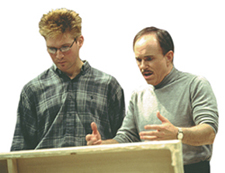 |
|
Professor Alan Wade (right) is Serge in the Olney Theatre Center’s production of the three-character comedy, Art.
|
Alan Wade has been teaching students to act, directing them in plays, and providing career mentoring for them during his nearly 25 years at GW. This spring, he adds a new role to his repertoire: Professor Wade will teach at Washington’s Academy for Classical Acting at The Shakespeare Theatre, a collaboration between the Theatre and GW that provides advanced classical training to professional actors.
This may seem a full plate, but it’s only half of his story. He has found time to be a working actor and director as well, with more than a hundred roles on stage, film, and TV under his belt—not to mention perhaps 20 directorial credits. It’s no wonder Wade describes himself as a man always pulled in many directions—and thriving in his busy life.
Most recently, he took on a plum role for the Olney Theatre Center—that of “Serge” in Parisian playwright Yasmina Reza’s three-character comedy, Art. Wade was cast as one of three old friends whose relationship to one another is threatened when Serge buys a piece of unusual and very costly art.
Wade says he became nervous early in the course of rehearsals.
“Nobody laughed—there’s nobody at rehearsals but the director and the stage manager and once they’ve heard it funny—well, it’s simply not going to be funny the fifth time you do it!” He continues, “So, for most of the rehearsal period, there wasn’t any laughter. I must say I was becoming concerned; it was being billed as a comedy, people were going to come here expecting to see comedy, and I didn’t think anybody was going to laugh!” Wade need not have worried. The Olney production drew laughs galore and excellent reviews.
His story stands in counterpoint to one about playwright Yasmina Reza that Wade tells with great relish. It seems that when she first saw her play performed, she was crestfallen when the audience laughed. They guffawed. Howled. Winked and elbowed each other. In short, the audience reacted every way but the way Reza had expected. She thought they were laughing at her play, for she had not set out to write a comedy!
Nonetheless, she had written a very funny play. The laughs she heard signaled success. Art went on to win a Moliere Award in Paris and an Olivier Award in London, an Evening Standard Award for best play in London, and the 1998 Tony Award for best play on Broadway.
Wade enjoyed his stint as Serge, a character of rather pompous “snootiness,” in Wade’s words. But versatility is a key characteristic of successful actors, and it’s a trait that marks Wade’s career. Some diverse roles that come to mind include Michael, the Brit held hostage in Lebanon in Someone Who’ll Watch Over Me and film roles in Pelican Brief and Major League II. Back on stage, recently he played the Ragpicker and Sewerman in The Madwoman of Chaillot.
He continues looking for ways to flex his theatrical muscles, and to that end mentions an old theatrical tradition in which Othello and Iago rotated into each other’s roles. He tells us that he had suggested a similar rotation of roles for the three Art characters, but to do so would have taken too much added rehearsal time. However, Wade hasn’t quite yet given up on getting his chance to play the others—quirky Yvan, grumpy Marc—since Olney has a history of occasionally bringing back very successful plays. Wade says that Christopher Lane (“Yvan”) asked him on the final night if he were ready for a “remount” of the play.
Alan Wade appears positively intrigued by the idea. “Just give me a few months,” he says, “I could be ready.”
—SH
Back to top | Spring 2002 Table of Contents

Two Million and Counting
Oct. 19 was a very big day for the Gelman Library System. The day marked the presentation of Gelman’s two millionth volume, as well as the dedication of its Wall of Honor to recognize its donors. Shown in the photo in front of the wall, from left, are University Librarian Jack Siggins, President Trachtenberg, Trustee Emerita Estelle Gelman, and Friends of the Library President Walter E. Beach. Among other honored guests were Professor Emeritus of German James C. King, who presented the two millionth book—an 1838 atlas of the United States. (Watch for a special feature on the Gelman Library System in our fall 2002 issue; in the meantime, any questions may be addressed to Jack Siggins at 202-994-6455.) |
Back to top | Spring 2002 Table of Contents

Petrie to Lead Emergency Management Effort
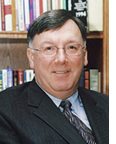 Retired Navy Captain John N. Petrie, former Commanding Officer of Naval Station Norfolk, recently was named to the position of assistant vice president for public safety and emergency management. The newly created position is designed to broaden, coordinate, and execute the University’s crisis management, emergency preparedness and public safety plans and activities. Retired Navy Captain John N. Petrie, former Commanding Officer of Naval Station Norfolk, recently was named to the position of assistant vice president for public safety and emergency management. The newly created position is designed to broaden, coordinate, and execute the University’s crisis management, emergency preparedness and public safety plans and activities.
“The tragic events of Sept. 11 and their aftermath have resulted in changes in the way all of us conduct our lives,” said President Stephen Joel Trachtenberg. “Just as GW strives for academic excellence, we also want to take all appropriate steps to ensure the safety and well being of our community. In Dr. Petrie, we have an emergency preparedness expert with an impressive record of success in the military who will be sensitive to the values of higher education.
Petrie brings more than two decades of experience to GW, including most recently service as executive director of the Chief of Naval Operations Executive Panel. Prior to that position, Petrie commanded Naval Station Norfolk—managing a $200 million budget, a $1.2 billion physical plant, and directing a staff of 5,000 in operating the world’s largest naval complex.
GW Vice President for Communications Michael Freedman noted the overriding importance of the creation of the new position and the person selected to hold it. “It speaks to the seriousness with which the University views the current world situation and the vital concern we feel for the safety of every member of the GW Community,” he said.
The new assistant vice president received his AB degree from Villanova University and he holds a master’s and doctorate from The Fletcher School of Law and Diplomacy.
—SH
Back to top | Spring 2002 Table of Contents

Feldman Named D.C. Professor of the Year
|
|
|
Associate Professor of Physics Gerald Feldman consults with a student in the Physics Help Room. |
Associate Professor of Physics Gerald Feldman was honored in November as the District of Columbia Professor of the Year by the Council for Advancement and Support of Education.
The coveted prize came as quite a surprise to the experimental nuclear physicist, who launched his professorial career five years ago. Feldman came to GW in 1996 after serving as a researcher at the University of Saskatchewan in Saskatoon, Canada. “There, my contact with students was generally limited to working with graduate students at the university’s electron accelerator laboratory,” says Feldman.
Shortly after arriving at GW, he began to make a huge impact on physics education by creating a Physics Help Room, along with Associate Professor of Physics Cornelius Bennhold. “We used to have office hours and nobody would come, perhaps because they felt it was too intimidating a setting,” says Feldman. “When I was a graduate student at the University of Washington, there was a small, informal tutoring room which was extremely popular with the students, so we decided to initiate something similar at GW.”
Almost immediately, GW’s Help Room became a hit with students, who stop by throughout the week to bounce ideas off of faculty members and fellow students and work on their computer-based homework assignments.
Feldman and Bennhold are also the driving forces behind the physics department’s recent introduction of Respondex, an innovative, in-class electronic student response system that polls the class with interactive questions. “Every student has a keypad, where they input answers to multiple choice conceptual questions based on the topic of the day,” says Feldman. “Then the data are collected, a histogram of the response displayed, and students turn to their neighbors and discuss their answers. Our hope is that students shift their answers to the correct response by learning from each other. This type of peer instruction helps students become thinkers, not just memorizers.”
Another Feldman innovation at GW is the Computer Assisted Personalized Assignment system for homework. “Students answer individualized homework questions stored on a Web site and get immediate feedback as to whether they are right or wrong,” he says. “That way, they can keep on trying until they get it and hopefully learn from their mistakes. It’s also a great solution to grading 200 papers!”
Feldman says that his main goal is to develop students’ critical thinking skills and to get them more actively involved in the learning process. “I can’t stand there and pour knowledge into their heads,” he says. “Hopefully, we’ve ratcheted up the standard, raised the bar higher, and increased scientific literacy among our students.”
Feldman confides that he’s amazed to have won the CASE award at such an early stage in his teaching career. “In a sense, it’s ironic to get an award for teaching, because I consider myself more a coach than a teacher,” he says. “The students do the work and I facilitate the development of their skills. I feel that the more you can get students to do on their own, the better teacher you are. I guess you can say that I got a teaching award for doing minimal teaching.”
—Jamie L. Freedman
Back to top | Spring 2002 Table of Contents

Something Old, Something New, Something Buff and Gold and Blue
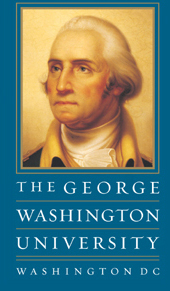 The day was festive, and appropriately so. After all, it was the 270th birthday of the University’s namesake, General George Washington. The occasion was marked in many ways—a celebratory evening bonfire and a grand ball the following night that paid tribute as well to the 90th anniversary of the University’s relocation to the Foggy Bottom section of the city. The day was festive, and appropriately so. After all, it was the 270th birthday of the University’s namesake, General George Washington. The occasion was marked in many ways—a celebratory evening bonfire and a grand ball the following night that paid tribute as well to the 90th anniversary of the University’s relocation to the Foggy Bottom section of the city.
But first, big news came from President Trachtenberg, hosting a 10 a.m. unveiling of the University’s new visual identity. It was inspired by a painting of General Washington by 19th century artist Rembrandt Peale that is in GW’s Permanent Collection. The new identity system draws on the University’s traditional colors in new applications, and on typefaces that join with the portrait to present the University in an elegant, dignified manner.
The president spoke to those gathered about the importance of unified communications, and he underlined his message with a letter that expanded upon his speech. The letter emphasized that the purpose of the new visual identity system was to aim for consistency in visual imagery in all GW communications. He said that the uniformity of the University’s image would allow each entity to reinforce others and create an image of the University that is greater than the sum of its parts.
Guests at the unveiling saw not only the new identity system but also the Peale portrait of George Washington—which ordinarily hangs in Trachtenberg’s Rice Hall office. The painting was on display for this special occasion in the University Art Gallery.
The original oil painting, dating from around 1850, is rendered on canvas, 36”x28.” It is one of Peale’s so-called “porthole” portraits, in which the trompe l’oeil stonework oval that surrounds the portrait gives the effect of a porthole. GW purchased the portrait in 1955 from Walter P. Chrysler, Jr. It has been exhibited on “The American Freedom Train” and at the B’nai B’rith Klutznick National Jewish Museum.
University offices have already begun using the new logo system; full implementation is expected to be complete university-wide by fall 2002.
—SH |
Back to top | Spring 2002 Table of Contents

Dean Receives “Extraordinary Contributions” Award
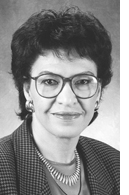 Mary Hatwood Futrell, dean of GW’s Graduate School of Education and Human Development, was honored by The American Association of Colleges for Teacher Education as the recipient of the 2001 Imig Award for Extraordinary Contributions to the Shaping of Teacher Education Policy at the State and National Level. The award highlights the importance of positive policy making on behalf of high-quality teacher education. Mary Hatwood Futrell, dean of GW’s Graduate School of Education and Human Development, was honored by The American Association of Colleges for Teacher Education as the recipient of the 2001 Imig Award for Extraordinary Contributions to the Shaping of Teacher Education Policy at the State and National Level. The award highlights the importance of positive policy making on behalf of high-quality teacher education.
Futrell, whose specialty is in education reform policy, professional development and diversity, came to GW in 1989 as a senior fellow for the School of Education and Human Development and became dean in 1995. She is also a professor of education, director of GW’s Center for Curriculum, Standards and Technology, and president of Education International.
In 1983, Dean Futrell served as president of the National Education Association. She was named woman of the year by Ms. Magazine and honored by Ebony magazine as one of the 100 most influential black Americans. Futrell earned her BA in 1962 from Virginia State College, now Virginia State University. She earned an MA in secondary education in 1968 and an EdD in education policy studies in 1992 from GW.
—Allison Gaddess
Back to top | Spring 2002 Table of Contents

GW Launches Summer Tour for Curious Minds
GW is going to camp, but it’s like no camp you’ve ever seen.
 “The GW Summer Tour: Curious Minds Rock,” is a new summer day camp program for kids that will challenge minds as well as bodies. It offers a surprising array of activities from gourmet cooking, rocketry, and magic to Tae Kwon Do, tennis, and rollerblading. “The GW Summer Tour: Curious Minds Rock,” is a new summer day camp program for kids that will challenge minds as well as bodies. It offers a surprising array of activities from gourmet cooking, rocketry, and magic to Tae Kwon Do, tennis, and rollerblading.
The co-ed program, offered for the first time this summer, lasts four weeks and consists of two two-week sessions—July 8-19 and July 22-Aug.2. The camp is geared for youngsters entering third through eighth grades.
The idea for the Summer Tour came from University Vice President for Student and Academic Support Services Robert Chernak. GW had run a popular sports day camp for several years, but Chernak believed that a university should provide children with intellectual stimulation as well—“so they can engage in the discovery of learning.” The result, says Chernak, is a lively experience “where young minds are challenged but not tested.”
The Summer Tour will be held mostly at GW’s Foggy Bottom campus, though some sports will be at GW’s Mount Vernon campus. Directing the program is Bridget Cooper, an experienced camper who bubbles with enthusiasm for her new mission. She herself went to an enrichment camp at Wellesley College when she was a child and she recalls, “It’s exciting for kids to come to a college campus.” Cooper holds a master’s degree in counseling and is working on her doctoral dissertation at GW’s Graduate School of Education and Human Development.
One of the special features of the Summer Tour is the degree of choice offered to campers. Cooper explains, “When they sign up, they also choose how they want to spend their summer.”
The camps will accommodate between 200 and 300 campers per session, Cooper says, with a counselor-camper ratio of 1:10. Vice President Chernak explains that the Summer Tour is being kept small its first year, so quality and safety can get full attention.
The array of activities offered is enough to rock any child’s mind (for a full list, see http://gwired.gwu.edu/curiousmindsrock and go to course descriptions, or call Cooper at 202-994-3156). The choices range from kite making and flying to secrets of Egyptian mummies, and from video game design to a variety of athletic activities.
Having so many unusual activities means that many staffers on the Summer Tour will have special qualifications. “E.R. 4 Me” will include rotations in the GW Hospital emergency room, led by doctors and medical students, and “Frosting Feats” will be taught by a professional pastry chef.
The first Fridays of each session will be devoted to field trips, tentatively scheduled for places like the NASA Space Flight Center, CBS Radio, an ice cream factory, or backstage at the Kennedy Center. The last Friday of each tour, to which parents are invited, will include special sports competitions and closing ceremonies.
The cost for each two-week session is $700, with discounts for families who send two or more campers and for campers who attend both sessions. Some special activities like photography may require an additional fee for materials.
Cooper says that the Summer Tour is accredited by the American Camping Association. In addition to the Summer Tour, GW offers some special sports camps— call (202) 994-2013 for information about boys’ basketball camps or (202) 994-5879 for information about the volleyball camp for girls.
GW officials expect a good turnout for the Summer Tour. Notes Mike Gargano, the associate vice president for student services who is responsible for the program, “Most camps run by colleges are either one or the other—athletic or intellectual. We’re unusual in that we have a wide selection of both recreation and enrichment activities. There’s nothing like this in the Washington metro area.”
Cooper is pleased with the initial response. She reports, “More than one parent has told me, ‘I want to be a kid again and go to your camp.’”
—Bob Guldin

At a Glance
District Honors Ticktin
Assistant professor and associate director of the program in Judaic studies, 79-year-old Max Ticktin is this year’s Outstanding Older Worker of the District of Columbia. The special recognition comes as part of the fourth annual National Prime Time Awards. Ticktin teaches older adults when not teaching at GW. One reason for his award can be deduced from a comment from Religion Department Chair Paul Duff: “…it is difficult to find time simply to chat. Fortunately though, a short conversation with Max is worth a much longer one with most other people.”
GW Board Approves 4.5 Percent Hike
The Board of Trustees approved a 4.5 percent overall increase in full-time undergraduate costs for the 2002-03 academic year, the University announced in February. Some fees that had been charged separately will be rolled into the cost of tuition. Tuition and fees will increase by 4.9 percent. The room and food allowance increase of 3.2 percent includes a $200 reduction in the cost of the basic food plan. In addition, funding for student financial assistance programs is expected to rise to more than $94 million—an increase of more than $9.8 million. Other school increases are the Law School, up by 4.9 percent; Medicine and Health Sciences, 4 percent increase for first-year students and 3 percent for second, third, and fourth-year students. The increase at the graduate level is 3.2 percent.
Fulbrighters All
Assistant Professor David I. Liban, director of GW’s Electronic Media Program in SMPA, is spending February through May at the Portuguese Catholic University thanks to a Fulbright grant. Meanwhile, 14 visiting scholars from abroad will spend some or all of the 2001-02 year at GW. Countries as varied as Sweden, Taiwan, Jordan, Ukraine, France, Japan, Tunisia, India, and Morocco are represented at GW among this year’s visiting scholars.
GW Offers E-Business Course
The e-business program at GW’s Virginia campus has partnered with Accenture (formerly Anderson Consulting) and IMT Strategies of Stamford, Conn., to offer a unique e-business graduate course. The course is being team taught by Accenture executives and IMT President Stephen Diorio, whose book, Beyond e: 12 Ways Technology is Transforming Sales and Marketing Strategy, provides content for the class. The course intends to challenge sales and marketing executives to look beyond current e-business fads to understand the fundamentals that will distinguish leaders in the future.
Presidential Public Service
President Trachtenberg will serve on the Board of Governors of the Partnership for Public Service, a newly formed non-partisan, non-profit organization dedicated to revitalizing public service. A survey of attitudes toward federal government service revealed that college-educated Americans virtually reject the government as a prospective employer. The goal of the partnership is to restore public confidence in and prestige to the federal civil service as a means to hiring and retaining high-achieving employees.
Hungarian Honors for Akos Vertes
The Hungarian Academy of Sciences recently bestowed the title of “Doctor of the Hungarian Academy of Sciences” on Chemistry Professor Vertes. He also was made a member of the General Assembly of the academy, which is the most prestigious scientific institution in Hungary. The honor is based in Vertes’ work between 1985 and 2000 in the field of ion generation with plasmas and with soft ionization methods.
Reagan Adviser Is Shapiro Fellow
Peter D. Hannaford, former Reagan campaign adviser and current president of public relations and public affairs consultancy Hannaford Enterprises, Inc., joined the School of Media and Public Affairs as a Shapiro Fellow. As part of the program, designed to bring respected professionals to the school for the benefit of the students, Hannaford will give a lecture on the war on terrorism and offer a series of current-issue, brown-bag lunch discussions.
Correction
In our winter 2002 review of his book, The Price of Terror, author Allan Gerson’s title was incorrect. He is research professor of international relations in the Elliott School of International Affairs.
Back to top | Spring 2002 Table of Contents

GW in History
25 Years Ago
The government of Kuwait sent 115 college students to the United States. Twenty-one of these students came to GW—all freshmen majoring in engineering. According to one of the students, when they go home (after two or three years) they will “owe” the Kuwait government work for the same amount of time they studied in America. GW enrolled 1,800 students from 110 different nations in the year 1977.
50 Years Ago
President Cloyd Heck Marvin celebrated his 25th anniversary as GW president at commencement, where President of the Board Robert V. Fleming read the Trustees’ acclamation of Marvin’s “fruitful accomplishments,” and outlined the effectiveness of his quarter-century of service. The citation stated that “[h]e has met the challenge of the times and the demands of a growing university with skill, with vigor and with dedication. His monument is the University of today and the greater University of tomorrow.”
100 Years Ago
From the 1902 bulletin of The Columbian University, expenses of study, which were payable in advance semi-annually, included:
- Matriculation fee $10.00
- Tuition for the year in three or more departments $100.00
- Tuition for the year in two departments $70.00
- Tuition for the year in one department $40.00
- Final diploma fee $10.00
We should append, for perspective, that in the newspapers of the year, men’s summer suits were advertised for $6.75 each, and Thomson’s True-Fitting women’s corsets were going for 33 cents.
The Magazine gratefully acknowledges the assistance of University Archives in the identification of interesting historical information. Readers wanting to learn more about GW’s history can find the University Archives Web site by accessing www.gwu.edu/~archives. The site’s Historical Almanac is especially informative.
Back to top | Spring 2002 Table of Contents

|